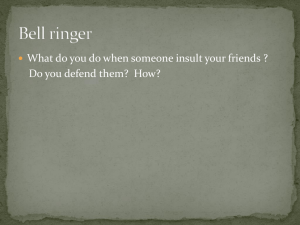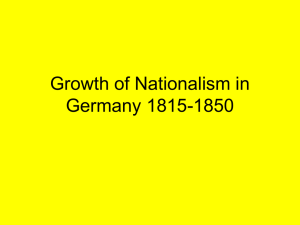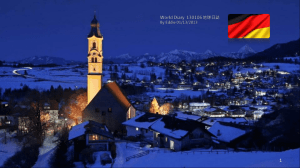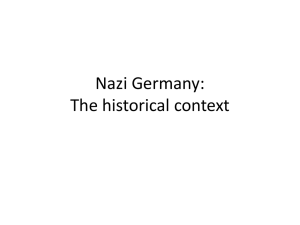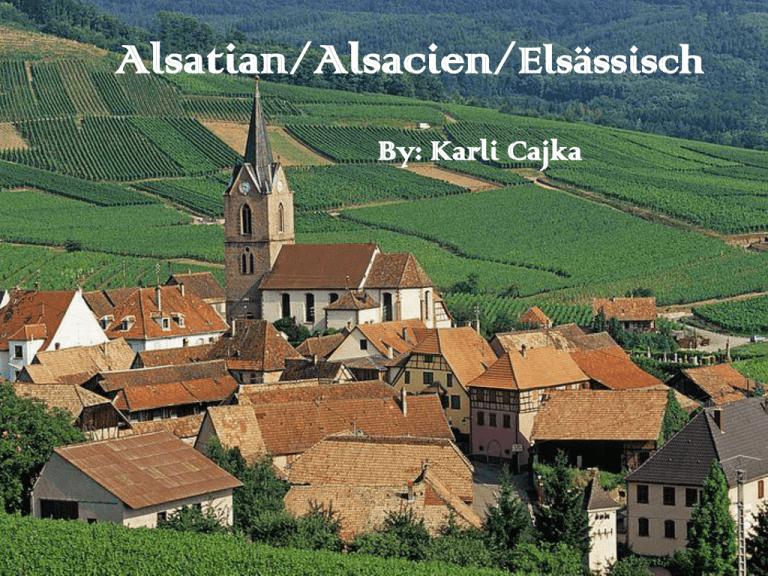
Alsatian/Alsacien/Elsässisch
By: Karli Cajka
What is Alsatian?
• Alsatian is a German Alemannic dialect spoken in Alsace,
the eastern region of France.
• Though it is a German dialect, it is largely influenced by
French.
• Alsatian is not easily intelligible to speakers of standard
German, but it is closely related to other Alemannic
dialects, such as Swiss German and Swabian.
• Some people have a hard time differentiating Alsatian from
French since it has become very similar.
• It is often confused with the Frankish language, a more
distantly related German West Franconian dialect. Both
languages are called Alsacien in French.
Where is Alsatian Spoken?
Alsatian is a German Alemannic dialect spoken in Alsace, the eastern region of
France.
~Numerals~
(dialect spoken in region of Colmar)
•
•
•
•
•
•
•
•
•
•
•
•
•
•
•
•
•
•
•
1 – ein
2 – zwei
3 – drèï
4 – viar
5 – femf
6 – sex
7 – sewwa
8 – ååcht
9 – nîn
10 – zeh
11 – elf
12 – zwelf
13 – drize
14 – viarze
15 – fùffze
16 – sæchze
17 – sewweze
18 – åchtze
19 - nînze
•
•
•
•
•
•
•
•
•
•
•
•
•
•
•
•
•
•
•
1 – un
2 – deux
3 – trois
4 – quatre
5 – cinq
6 – six
7 – sept
8 – huit
9 – neuf
10 – dix
11 – onze
12 – douze
13 – treize
14 – quatorze
15 – quinze
16 – seize
17 – dix-sept
18 – dix-huit
19 – dix-neuf
~Numerals Continued~
•
•
•
•
•
•
•
•
•
20 – zwånzig
30 – drissig
40 – viarzig
50 – fùffzig
60 – sæchzig
70 – sewwezig
80 – åchtzig
90 – nînzig
100 - hùnd’rt
•
•
•
•
•
•
•
•
•
20 – vingt
30 – trente
40 – quarante
50 – cinquante
60 – soixante
70 – soixante-dix
80 – quatre-vingts
90 – quatre-vingt-dix
100 - cent
~Months~
•
•
•
•
•
•
•
•
•
•
•
•
January – Janner
February – Fewrier
March - d'r März
April – Àwrel
May - d'r Mai
June – Jüni
July – Jüli
August - d'r Àuigscht
September – septamber
October – Oktower
November – Nowamber
December - Dezamber
•
•
•
•
•
•
•
•
•
•
•
•
Janvier
Février
Mars
Avril
Mai
Juin
Juillet
Août
Septembre
Octobre
Novembre
Décembre
Romance Language
Family Tree
• Alsatian is a High German dialect known to philologists as Alemannic.
Speakers, Cities, Regions
•
•
•
•
•
•
•
Spoken in Alsace, the eastern region of
France.
About 96,000 speakers, or 60% of Alsace
inhabitants.
Majority of speakers are adults; 36% of
primary school pupils can speak the dialect.
Two main forms of the dialect are the BasRhin dialect spoken in northern Alsace and
the Haut-Rhin dialect spoken in southern
Alsace; these are also known as the High and
Low Alemannic versions.
There is also an obscure Frankish dialect
spoken in the Wissembourg region and a
Romance dialect called Welche from the
valleys around Orbey. Different versions are
spoken in every town!
Spoken in parts of Baden-Wurtemburg in
Germany and the German speaking part of
Switzerland (which is about 60% of
Switzerland).
Today it is mostly spoken in rural areas, and
even parts of Lorraine.
Linguistic & Sociopolitical History
•
•
•
•
•
•
•
•
•
•
•
•
Alsatian was passed between French and German control many times in its history.
It was actively discouraged under both French and German rule.
During the French Revolution, the language was suppressed in favor of French for
nationalistic reasons, but it was ousted by German when the Prussians annexed the region in
1870.
When French rule resumed, all things Germanic were frowned upon, and many Alsatians
began to speak French again.
But then the Nazi occupation brought in laws that made the speaking of French and even the
wearing of berets imprisonable offences.
The flip-flop between French and German rule made it challenging for the people to identify
themselves in terms of their language.
Both France and Germany claimed the Alsatian people as their own and created contrasting
arguments for either French or German cultural nationalism.
Each nation relied on language as the primary means for identifying and ensuring national
loyalty to itself
Today, most daily transactions are conducted in French, and Alsatian has not made it onto
the school curriculum.
However, it is a living language with a rich medieval literary legacy and is still spoken by
young and old throughout Alsace.
Alsatian Is beginning to appear on signs and to be spoken at the official level, too.
German Vs. French Arguments
French vs. German!
Language Status
* Many speakers write in standard German, although street names, which were formerly only in
French, may use local spellings.
* Today, most daily transactions are conducted in French, and Alsatian has not made it onto the
school curriculum.
* However, it is a living language with a rich medieval literary legacy and is still spoken by
young and old throughout Alsace.
* Alsatian is beginning to appear on signs and to be spoken at the official level, too.
* Most speakers are adults because there is hardly any media coverage in the language,
diminishing its transmission to the younger generation.
* With the French language so dominant as the regional language, it is amazing that people still
converse in Alsatian.
* There are some potential challenges to the longevity of the language, but it is not in immediate
danger of becoming extinct.
* A foundation called “Heimetsproch un Tradition” started in September 1984 in Selestat has
brought men and women together to preserve the perpetuation of the culture and regional
language of the German-Alsatian and Franconian-Lorraine or Alsatian dialects. The
association has 3,000 members and is the largest association working in this field in Alsace;
their main channel of communication is their journal which has 6 issues a year containing
commentaries, proposals, and articles on the history and cultural foundations of the region,
biographies, the people’s theatre, regional literature, poetry and prose, the groups’ activities,
and courses enhancing the appreciation of the people’s regional culture etc.
~Pop Culture~
•
•
•
•
•
•
•
•
•
•
•
•
•
•
•
There is limited usage of Alsatian in the media.
There is one radio station, Radio France Alsace http://sites.radiofrance.fr/chaines/france-bleu/?tag=alsace
which broadcasts in Alsatian.
Other radio and TV stations broadcast some programs in the dialect.
The lack of Alsatian in the media has prevented younger generations from exposure to the lanaguage.
There are websites which contain news of the Alsace region of France, but they are not found in the
Alsatian language: http://kiosko.net/fr/np/alsace.html
The oldest known poem written in the German language was written in Alsace because humanism
flourished there and leaders of the German peasant revolt of 1525 came from that region.
It is significant to the importance of the printed word in Alsatian that Gutenberg arrived in Strasbourg in
1434 where he would develop his printing press with moveable type.
Albert Schweitzer, the most important Alsatian figure of the 20th century, contributed with literature in
dialect.
In the early 1980s, Alsatian literature (in the form of songs and poetry) was rediscovered.
Alsatian folklore was published in modern French, however.
Modern Alsatian literature is expressed in French, German, and Alsatian dialect.
Prominent writers and poets include Maxime Alexandre, Jean-Hans Arp, Gaston Jung, Alfred Kern,
Marcel Schneider, and Claude Vigee.
Alsatian literature can be found at La Librairie Oberlin and at the annual Salon du Livre, in Colmar,
during November.
There is a collection of manuscripts dating from the seventh to the 16th century and tracing the evolution
from handwritten to printed work.
The Theatre Alsacien de Strasbourg, located at the Theatre Municipal presents traditional shows and
political satires in French and Alsatian.
~Alsatian in Education~
• Because French is the offical language of the
country, Alsatian has not made it into the
school curriculum.
• Throughout the history of this region,
depending on whether it was under the
control of Germany or France, either one of
the two languages has always been taught in
schools to inspire nationalism.
~Food & Wine~
•
•
Gewurztraminer
What we could be eating…
~Webpages~
•
•
•
•
•
•
•
http://culture.alsace.pagesperso-orange.fr/dictionnaire_alsacien.htm
This website provides a dictionary that can go from French to Alsatian and Alsatian to French.
There is no English translation.
http://www.alsa-immer.eu/index.html
This website is dedicated to addressing the issues which face the status of the Alsatian language. It
can be translated into French.
http://alsacecanoes.free.fr/articles.php?lng=fr&pg=2716
This website is for renting canoes. Some of the navigational links are in English, which suggests
that this website might be used by English-speaking tourists.
http://www.orthal.fr/sites_alsMul.htm
This website is dedicated to preserving the written word in Alsatian. It has links to texts in Alsatian.
http://als.wikipedia.org/wiki/Els%C3%A4ssischer_Dichterweg
This website shows how Wikipedia can be searched in the Alsatian language.
http://www.youtube.com/watch?v=KFA87W76mqg&NR=1
This youtube video is coffee advertisement with George Clooney. All of the dialogue is in Alsatian.
http://www.olcalsace.org/de/lexiques-francais-alsacien/elsassisch-franzosische-glossare.html
This website appears to be another devoted to the preservation of the language, complete with
links to different texts offered in Alsatian about the culture.
~Sources~
• http://www.omniglot.com/writing/alsatian.htm
• http://www.languagesandnumbers.com/how-to-count-inalsatian/en/gsw-fra/
• http://france-for-visitors.com/alsace/alsatian-language.html
• http://www.getalsaced.com/alsatian-language.html
• http://www.mtholyoke.edu/~jihazel/pol116/language.html
• http://thelanguagechronicle.com/the-alsatian-language/
• http://www.heimetsproch.org/introduction.html
• http://www.faqs.org/minorities/Western-Europe-andScandinavia/Alsatians.html
• http://www.faqs.org/minorities/Western-Europe-andScandinavia/Alsatians.html9


